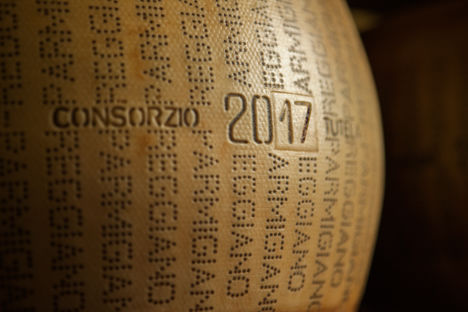
5 things you never knew about Parmigiano Reggiano
Parmigiano Reggiano is quite simply one of the best cheeses in the world – but its legacy goes far beyond cooking and cuisine. We take a look at some of the facts and stories surrounding this cheese that cement its cultural dynasty.
5 things you never knew about Parmigiano Reggiano
Parmigiano Reggiano is quite simply one of the best cheeses in the world – but its legacy goes far beyond cooking and cuisine. We take a look at some of the facts and stories surrounding this cheese that cement its cultural dynasty.
Undeniably one of the most lauded, well-known, and popular cheeses in existence, Parmesan (or Parmigiano Reggiano DOP, to give it its full name) is a product that transcends the world of food. Not only has it become part of the wider culture in its homeland of Italy, but throughout history it has garnered attention globally, breaking records, making appearances in famous works of literature, and often even making international news. There simply isn’t a cheese out there with a more colourful and intriguing past than Parmigiano Reggiano – and the following facts and tales prove it.
The one and only Parmesan
Parmigiano Reggiano can only be made in a specific area of northern Italy (Parma, Modena, Reggio-Emilia, and parts of Mantua and Bologna), gaining Protected Designation of Origin (PDO) status in 1996. This means that cheese made outside these areas cannot legally be called Parmigiano Reggiano and therefore cannot legally display the marks and brands which make a wheel of Parmigiano Reggiano so instantly recognisable. In the EU and other countries where the European laws apply, Parmigiano Reggiano is also the one and only Parmesan – the only cheese that can legally use this name. If you want to be absolutely sure that you are definitely buying Parmigiano Reggiano, be sure to look out for dots on the rind that spell out the name of the cheese, or if you’re buying a whole wheel, it’s actually possible to check its origin using a unique identification number printed on the flat side of the wheel.
A royal gift
Although production of Parmigiano Reggiano is believed to date back to over 1,000 years ago, it was during the medieval times that news of this exquisite Italian cheese began to spread further afield in Europe. By the sixteenth century it was incredibly sought after in Britain because of its unique flavour, but it also drove very high prices as importing it from Italy was a long and expensive process. This meant that wheels of Parmigiano Reggiano fast became a gift of the upmost luxury and in 1511, Pope Julius II is said to have made a gift of 100 wheels of Parmesan to Henry VIII, which today would be worth well over £50,000. Royal gifts like these only brought the cheese to the attention of more people; in the famous diaries of Samuel Pepys, during the fire of London in September 1666 he wrote ‘I did dig another [hole], and put our wine in it; and I my Parmesan cheese, as well as my wine and some other things.’ Parmigiano Reggiano had become such a coveted, highly prized food that Pepys buried his for safekeeping.
Space food
Parmigiano Reggiano is actually naturally lactose free, made with no additives or preservatives, as well as being a source of calcium and phosphorus. For this reason, over the past thirty years, Parmigiano Reggiano has become an increasingly common food for astronauts and has even been adopted by both NASA and the Russian space programme as an official 'space food'. Parmigiano Reggiano’s first trip into space took place in 1996, when two Italian astronauts brought some with them, making it the first raw milk cheese to be launched into space.
A shaky few days
One of the only problems with the production of Parmigiano Reggiano being centred around such a specific area of Italy is that if disaster strikes the region, the industry is immediately thrown into havoc. That’s exactly what happened in 2012 when two huge earthquakes hit northern Italy, damaging over 300,000 wheels of the cheese when they came tumbling down from warehouse shelves in the middle of the lengthy ageing process. Amounting to millions of pounds of damage, this immediately put the livelihoods of thousands of people and the wider industry in danger. Thankfully chefs including Massimo Bottura, a dedicated Parmigiano Reggiano advocate and owner of the three-Michelin-starred Osteria Francescana, quickly spread the word and people began to buy the damaged wheels, albeit at a slightly lower price than normal, ultimately aiding Parmigiano Reggiano’s financial recovery from the disaster.
Hidden treasure
The influence of Parmigiano Reggiano stretches beyond the real world. Over the years, the Italian cheese has provided inspiration for numerous authors and literary works. Parmesan may not often be associated with piracy, but one of its most famous appearances comes in Robert Louis Stevenson’s Treasure Island. Readers are told that protagonist Jim keeps a piece of Parmigiano Reggiano in his snuff box, adding that it’s very nutritious. So, it appears that even in 1883 when the book was written, people were already aware of the cheese’s health benefits.

